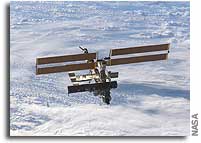ISS Status Report Friday, April 4, 2003

International Space Station crewmembers, Commander Ken Bowersox, Flight Engineer Nikolai Budarin and NASA ISS Science Officer Don Pettit, spent much of this week preparing for their spacewalk next Tuesday. The 6 1/2-hour spacewalk is scheduled to begin about 7:30 a.m. CST, with NASA Television coverage slated to start at 6 a.m.
Spacewalk tasks include reconfiguring power connections, providing a second power source for one of the station-s control moment gyroscopes, securing thermal covers on quick disconnect fittings for the station-s thermal control system, and releasing a light stanchion on one of the Crew and Equipment Translation Aid (CETA) carts.
The preparations included a talk with experts on the ground today, spacesuit and tool battery charging through much of the week, a detailed review Wednesday of the spacewalk timeline preceded by a checkout of the Simplified Aid for EVA Rescue (SAFER) by Pettit and followed by a 30-minute EVA conference with experts on the ground. Earlier in the week they had worked with EVARM (EVA Radiation Monitoring) equipment.
Expedition 6 crewmembers also prepared for their return home, members gathering and packing personal items and working to put the orbiting laboratory in top condition for its next residents. On Tuesday the Expedition 7 crew, Cosmonaut Yuri Malenchenko and Astronaut Ed Lu, was formally named. They are to be launched to the ISS from Kazakhstan in a Soyuz TMA capsule on April 26.
Bowersox, Budarin and Pettit will return to Earth in early May aboard the Soyuz TMA now attached to the Russian segment-s Pirs Docking Compartment. They were launched Nov. 23 and have been aboard the station since Nov. 25. Malenchenko and Lu will visit the Kazakhstan launch site at Baikonur next week to inspect the Soyuz TMA on which they will travel to the station.
Russian controllers at Mission Control Moscow today used thrusters of the unpiloted Progress cargo spacecraft docked to the Zvezda Service Module to increase the altitude of the station in preparation for arrival of the Expedition 7-s Soyuz. The 14-minute firing of the Progress thrusters raised the average altitude of the station by about 1.9 statute miles.
A wide range of science activities continues aboard the ISS. Pettit had spent considerable time since arriving on the station troubleshooting the power supply of the Microgravity Sciences Glovebox. The MSG provides a sealed environment for experiments that involve potential hazards like fluids, flame, fumes or particulates. After successful testing of his repairs, Pettit this week completed the increment-s first experiment runs in the facility. The MSG performed successfully in the InSpace (Investigating the Structure of Paramagnetic Aggregates from Colloidal Emulsions) experiment, which studies how particles and clumps of particles respond to an external magnetic field. Though the InSpace runs Monday and Tuesday produced unexpected results, many scientists were delighted to see the MSG working again.
Information on the crew’s activities aboard the space station, future launch dates, as well as station sighting opportunities from anywhere on the Earth, is available on the Internet at:
Details on station science operations can be found on an Internet site administered by the Payload Operations Center at NASA’s Marshall Space Flight Center in Huntsville, Ala., at:
The next ISS status report will be issued after next Tuesday-s spacewalk, or sooner if events warrant.








